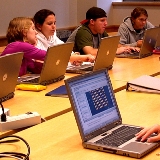Πηγή και πλήρες άρθρο με παραδείγματα.
Η δοκιμαστική έκδοση του προγραμματιστικού περιβάλλοντος Scratch 3.0, γραμμένο σε HTML5, βρίσκεται σε φάση ανάπτυξης και προβλέπεται η ολοκλήρωση της να πραγματοποιηθεί τον Αύγουστο 2018.
Στα 11, περίπου, χρόνια λειτουργίας του αποδείχτηκε ότι η μεγάλη εξάπλωση του «ανοιχτού λογισμικού» Scratch, παγκόσμια, οφείλεται και στην εκπληκτική «Κοινότητα» που δημιουργήθηκε από τον M.Resnick και την ομάδα του στο Media Lab του Τεχνολογικού Ινστιτούτου Μασαχουσέτης (ΜΙΤ) και παρέχεται δωρεάν.
Σύμφωνα με τα στατιστικά στοιχεία που δημοσιεύονται, τον προηγούμενο μήνα Μάιο οι εγγεγραμμένοι χρήστες (user registered) ήταν 28.989.643 και τα αναρτημένα προγράμματα (projects shared) 32.753.328.
Το Scratch 3.0 είναι γραμμένο σε HTML5 και είναι δημιούργημα της ομάδας του Scratch στο MIT σε συνεργασία με τη Google. Έτσι, φτιάχτηκε για να λειτουργεί κανονικά KAI στα κινητά τηλέφωνα ή tablets που χρησιμοποιούν το λειτουργικό σύστημα Android της Google, κάτι που δικαιολογεί το μέγεθος των blocks. Ας σημειωθεί ότι όσα αναφερθούν εδώ αφορούν αποκλειστικά στο προγραμματιστικό περιβάλλον και όχι στη δομή και το περιεχόμενο του website της «Κοινότητας του Scratch».
Ας δούμε τα βασικά χαρακτηριστικά
- Γίνεται προσπάθεια ώστε όλα τα projects που δημιουργήθηκαν με το τρέχον περιβάλλον Scratch 2.0 να τρέχουν στο νέο Scratch 3.0. Όσοι ενδιαφέρονται μπορούν να δοκιμάσουν τα δικά τους projects στη διεύθυνση https://preview.scratch.mit.edu/ με κλικ στο «View 2.0 Project»
- Τα περισσότερα blocks του Scratch 2.0 διατηρούνται και στη νέα έκδοση.
- Οι επεκτάσεις – extensions στο νέο Scratch 3.0. Αυτό που ολοκληρώνει και απογειώνει το Scratch με τα sprites – αντικείμενα στην οθόνη είναι η διασύνδεση τους με τον εξωτερικό κόσμο (όπως, για παράδειγμα με διάφορα ρομποτάκια και υπηρεσίες στο διαδίκτυο) με τη βοήθεια των επεκτάσεων – extensions της γλώσσας προγραμματισμού. Γνωρίζουμε ότι κάτι τέτοιο συμβαίνει ήδη με το Scratch 2.0 για τρεις μόνο περιπτώσεις που αναφερθήκαμε: PicoBoard, LEGO WeDo 1.0 και LEGO WeDo 2.0.Αλλά αυτές οι επεκτάσεις έχουν το χαρακτηριστικό να εμπλουτίζουν το Scratch και όχι μόνο για τον τομέα της εκπαιδευτικής ρομποτικής. Έτσι, οι επεκτάσεις μπορεί να αναφέρονται σε ποικίλους τομείς όπως η μετάφραση κειμένου από μια γλώσσα σε άλλη καθώς επιτυγχάνεται η σύνδεση με τη δωρεάν υπηρεσία Google Translate.Σημείωση: Ο εμπλουτισμός του Scratch 3.0 με ποικίλες επεκτάσεις μου θυμίζουν αυτές του πειραματικού διαδικτυακού ScratchX και αποτελούν, τελικά, τον προάγγελο τους.

